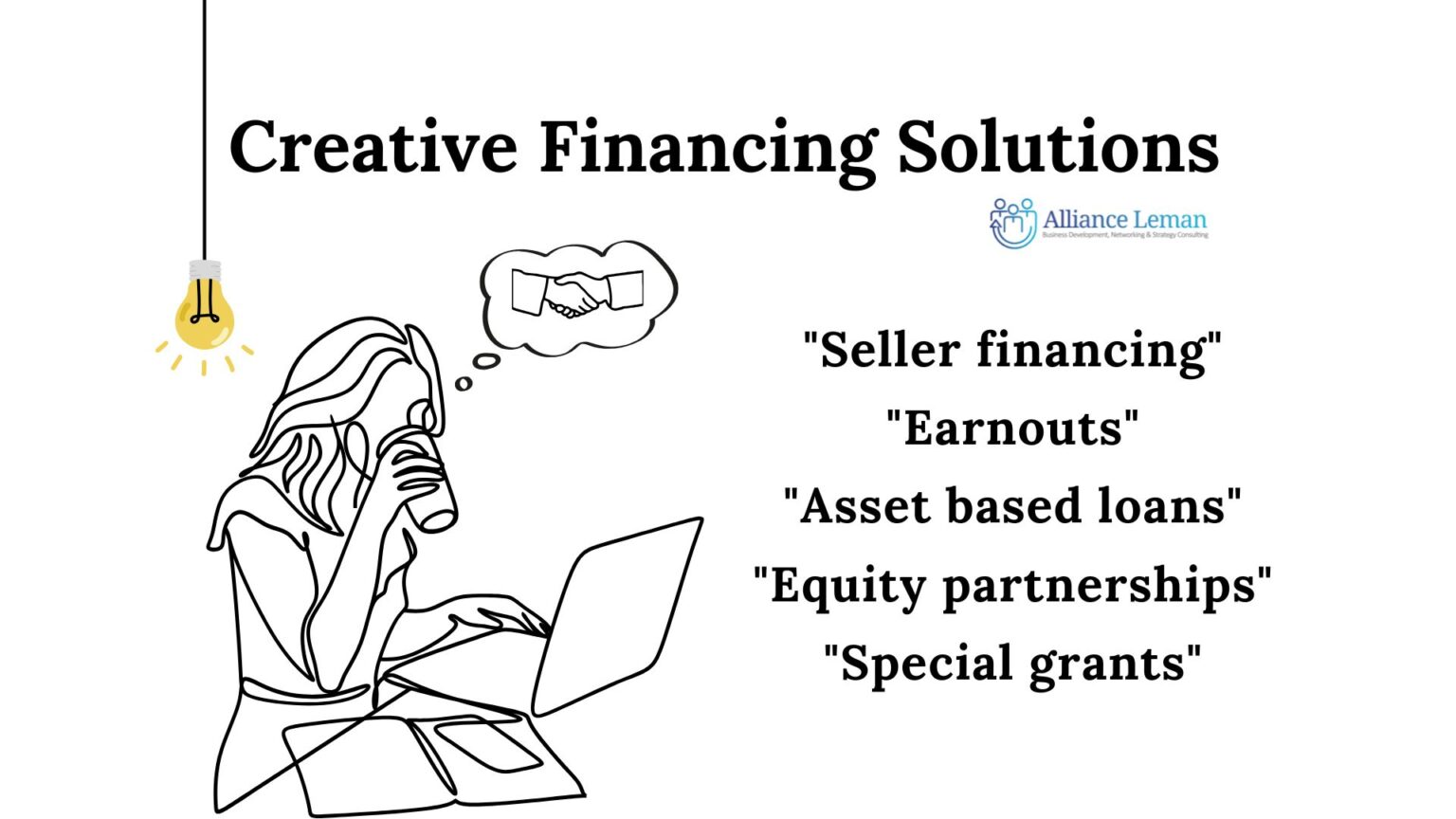
Creative Financing Strategies for Buying a Business
Table of Contents
Authors
-

Mojtaba is Alliance Leman's founding father. With more than 20 years of international experience in small to large scale projects, he writes to provide his insights on topics such as management, business development, and soft skills.
View all posts -

Fatemeh is a business strategy and M&A professional, with +5 years of international experience in heavy industry, and the financial & consulting industries- Her educational background is in Industrial Engineering & International Commerce
View all posts
A business is a living, breathing system—shaped by its past owners, swayed by market forces, and bound by economic realities like interest rates, inflation, and regulatory policies. Yet, despite these shifting dynamics lies a fundamental truth: business ownership remains one of the most effective paths to wealth creation.
In Main Street Millionaire: How to Make Extraordinary Wealth Buying Ordinary Businesses, Codie Sanchez challenges the idea that business ownership should be reserved for Wall Street elites. She shifts the focus to Main Street—the small, local businesses that quietly generate $6.5 trillion in annual revenue in the U.S.
Laundromats, plumbing services, car washes, coffee shops—businesses that are often dismissed as unglamorous but are, in reality, the backbone of the economy. Unlike the towering corporations of Wall Street or the stable, mid-sized firms of the middle market, Main Street businesses tend to be smaller, more owner-dependent, and sometimes lack pristine financial documentation.
This makes them riskier in the eyes of traditional investors. But risk, when understood properly, creates opportunity. For immigrant entrepreneurs willing to look past the hype of trendier sectors, these businesses present a unique chance to build generational wealth—especially now, as a wave of aging owners prepares to retire.
But recognizing a great opportunity is only half the battle. After defining the right business to buy (as we explored in our What to Consider Before Buying a Business series), one daunting question remains: How do I pay for it?
For many immigrant entrepreneurs, securing financing is the toughest hurdle. Limited local credit history, unfamiliar financial systems, and risk-averse lenders create a financing wall that can feel impossible to scale. The paradox is frustrating: you need a business to establish financial credibility, but financial credibility is often a prerequisite to owning a business.
So, what happens when traditional doors—bank loans, personal savings, investor-backed funding—remain firmly shut? This is where creative financing becomes a game-changer.
While traditional M&A deals rely on cash payments and bank loans, alternative methods like seller financing, earnouts, equity partnerships, and asset-based lending can bridge the gap between buyer and seller expectations. These strategies aren’t just theoretical—they are actively shaping both large-scale acquisitions and smaller Main Street deals.
In this article, we’ll explore how aspiring immigrant business owners can leverage these creative financing techniques to turn ambition into ownership—without being blocked by traditional financial barriers.
Let’s dive in.
The first option to consider is seller financing, where seller also acts as your lender
When bank loans are a dead end, seller financing can be a game-changer. In this setup, the seller steps in as the lender, letting the buyer take over the business while repaying the purchase price over time—typically with interest.
It’s a model built on trust. Both sides need to believe the business will not only survive but thrive under new ownership. On average, seller financing covers about 30% of the purchase price, but in some cases, sellers are open to financing the bulk of the deal—as long as there’s a reasonable down payment to show commitment.
Unfortunately, there are no specific statistics available of the percentage of deals including seller financing in the deal structure.
Take, for example, a seasoned chef eyeing a local restaurant. Without deep pockets, the chef negotiates a deal where part of the price is deferred, with payments structured around seasonal cash flow—lower in the slow winter months, higher when business booms.
This isn’t just theory. In early 2025, GEE Group’s acquisition of Hornet Staffing (both in the staffing industry) showcased seller financing in action, blending upfront cash with a deferred payment structure to bridge the gap between buyer and seller expectations.
The second option to consider is to agree on an earnout, where a part of the purchase price is tied to the companies’ performance
If seller financing is a bet on stability, earnouts are a wager on future performance. In this setup, part of the purchase price is tied to the business hitting specific targets after the sale—think revenue milestones, profit benchmarks, or subscriber growth. This makes earnouts especially useful in industries where today’s numbers don’t fully reflect tomorrow’s potential.
Take a SaaS acquisition in Silicon Valley: instead of paying everything upfront, the buyer structures the deal so the seller receives a payout after hitting 10,000 subscribers, then another when they reach 20,000. This way, the seller stays invested in the company’s success—often sticking around as an advisor to ensure those targets are met.
Earnouts have become more popular in recent M&A transactions as buyers and sellers turn to these provisions to bridge valuation gaps. About 21% of M&A deals had an earnout in 2023, up from 15% in 2015, according to data Cooley presented. In 2024, in the biotech and pharmaceutical industries, for example, more than 90% of M&A transactions contained earnout provisions. In the technology sector, 80% of corporate buyers indicated they would use earnouts or contingent considerations in future tech M&A transactions. (Source: Insights based on input Cooley’s and Morrison Forrester in collaboration with Mergermarket)
A real-world example is Bel Fuse’s acquisition of Enercon Technologies (both in the field of electronic manufacturing) in September 2024, which included up to $10 million in potential earnout payments based on future EBITDA.
But earnouts aren’t always smooth sailing. As Kevin Hagon of global consulting firm BRG notes, unclear performance targets can lead to post-sale disputes.
The third option is forming equity partnerships, bringing in a minority partner to share the risk and reward
At its core, financing is about managing risk—and when one person can’t shoulder that risk alone, partnerships offer a practical solution. Equity financing allows buyers to bring in investors—sometimes including even the seller—to share the financial burden and contribute strategic expertise.
Consider an entrepreneur eyeing a boutique hotel in a foreign country. An investor eager to enter the hospitality market but lacking local know-how might team up with a seasoned hotelier. This isn’t just an acquisition—it’s a strategic alliance, where capital meets operational expertise.
A large-scale example? OpenAI and SoftBank’s Stargate project. Here, SoftBank provides the financial firepower, while OpenAI brings the tech expertise, collaborating to build next-gen AI data centers. The same principle applies to smaller deals: partnerships can bridge funding gaps while adding strategic value.
Looking for a partner? A smart move is to ask the seller for a list of previous interested buyers who couldn’t secure financing at the time. They may now be ready to join forces.
The fourth option to consider is to pursue an asset-based loan
Every business, no matter its size, has assets—whether real estate, equipment, intellectual property, or inventory—that can serve as valuable leverage. With asset-based lending, these assets act as collateral for loans, meaning you might not need a hefty cash down payment to close the deal.
Take a restaurateur looking to expand: instead of relying on personal credit, they could use the value of their commercial kitchen equipment to secure financing. This shifts the focus from the buyer’s financial history to the intrinsic worth of the business itself.
It’s an appealing option for buyers, especially since it allows them to access 65% to 80% of the asset’s book value. And it’s not just small businesses reaping the benefits. In 2020, U.S. airlines like United, Spirit, and Delta used future cash flows from their loyalty programs as collateral, raising billions through asset-based loans.
Other options exist as well, including alternative avenues such as government or private grants
The financial world doesn’t operate in a vacuum; it’s deeply influenced by broader economic megatrends. Investors and lenders are increasingly focusing on sectors aligned with these global shifts, such as sustainability, digital transformation, and urban development. Entrepreneurs who align their acquisitions with these trends may find new and innovative financing opportunities.
For example, an investor looking to acquire a co-living property might bypass traditional mortgages in favor of sustainability grants aimed at combating urban housing shortages. Similarly, a tech entrepreneur seeking to acquire an AI-driven logistics firm could benefit from a blend of private investment and government incentives, tailored to support cutting-edge industries.
Immigrant entrepreneurs should consider partnering up with a local bilingual advisor or equity partner
For immigrant entrepreneurs, securing financing is about more than just numbers and balance sheets. Cultural barriers, unfamiliar regulatory environments, and local lenders’ cautious attitudes all play a role in shaping the process. In these situations, your network can often be just as valuable as your capital.
Forming partnerships with bilingual advisors, working with sellers who prioritize long-term success over immediate liquidity, and tailoring business plans to align with local market needs are key strategies to bridge these gaps. Sometimes, it’s that one critical connection—someone who truly understands both your vision and the local landscape—that can make all the difference.
Rethinking Financial Boundaries
In the world of business acquisition, financing is rarely a straightforward transaction—it’s a complex, often revolutionary shift in how we think about opportunity. What’s striking about the strategies we’ve discussed, from seller financing to creative partnerships, is their ability to reshape the rules of the game, challenging traditional financial systems that often seem out of reach for many aspiring entrepreneurs.
For those willing to look beyond conventional methods, the landscape is ripe for innovation. Creative financing isn’t just a workaround—it’s a new way of thinking about how business ownership can be accessible to a wider group of people, including immigrant entrepreneurs who may otherwise find themselves locked out of the system.
Ultimately, this is more than just about securing funds. It’s about unlocking potential—for both the business and for the individuals brave enough to challenge the status quo. In an era where the rules of success are still being written, the path to ownership is being redefined by those bold enough to make their own way.
Before you go
As a potential investor, make sure to read our “What to Consider Before Buying a Business” series:
- In Part 1, we established strategic foundations for business acquisition.
- In Part 2, we explored how to select the best markets.
- In Part 3, we evaluated whether to build or buy a business.
- In Part 4, we defined target criteria to guide your acquisition strategy.
- In Part 5, we guided you on ways to build a strong target pipeline.
- In Part 6, we showed you how to do an initial strategic filtering by doing commercial due diligence.
- In Part 7, we gave you keys to do a financial due diligence/ financial evaluation on your acquisition targets.
- In Part 8, we completed a final due diligence and got ready to close the deal!

